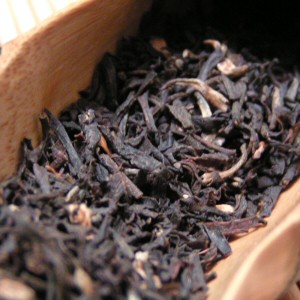Message
Types of Tea
Darjeeling and Assam
In the previous article, I praised first flush black estate teas and casually mentioned that they are very difficult to find in our (even specialized) shops. This ‘reserved character’ of estate teas, however, does not give cause for frustration. First, they are true elite drinks (which does not go together with public accessibility). Second, on shop displays (even in supermarkets) one can find rather decent teas. One only needs to know what to seek.This is quite easy to learn — one should realize what qualities teas of a certain kind possess. These very qualities will be described in this and following articles — this time I shall tell you of the qualities of Indian black teas. Traditionally, there are two main Indian tea-growing regions: Assam and Darjeeling. After the names of the regions the most widely spread and popular kinds of Indian tea are called Assam Tea and Darjeeling Tea.
 |
||
| Whittard Assam Orangajuli Tea. | ||
Indian state Assam (where tea of the same name grows) is located in the valley of the Brahmaputra River, where climate is hot and damp. This region is the homeland of the Assam variety of the tea bush. When growing wild, these ‘bushes’ can reach the height of 20 meters. In tea-gardens they do not let them grow so high, of course; otherwise, Indian women will not reach leaves, and they will have to train monkeys and giraffes to pluck. So, Assam tea is made of leaves of these very tree-bushes.
As well as other ‘subtropical’ teas, Assam makes a very strong brew of wonderful saturated color, with simple (but pleasant) flavor, rough, classic tea taste, and, if you are lucky enough, with a little malty by-taste. The words ‘if you are lucky’ mean that malty by-taste may show and, again, may not — it depends on the tea quality, the process of tea brewing, efficiency of the one who drinks tea, and position of sun-spots.
Assam may be called one of the classic English teas (I mean its popularity in England). You can add sugar and milk into it — however, to my exclusively Russian taste, you better not. Assam is breakfast/afternoon tea. Though, for breakfast, some prefer stronger teas — Ceylon teas or blends. The fact that Assam does for breakfast and lunch is determined not so much by its strength as by its ability to go with different food.
Sandwiches with butter-cheese-meat or with butter and salmon, cucumber sandwiches and other English snacks, pancakes with honey and condensed milk, any pastry — all of these will excellently go with Assam. And in most cases, snacks will not completely suppress the taste of tea. Probably, only Chinese Keemun (which will be described in the next article) can rival Assam in its ability to wash down anything.
Thus, if you plan a tea party with snacks, and snacks are going to be the main part of the occasion — Assam will be an ideal choice. In our supermarkets, you can find good Assam under the trademark Ahmad — but that should be with a blue label.
 |
||
| Whittard Darjeeling Margaret's Hope First Flush Tea. | ||
Darjeeling is a general name for a group of tea estates located at the foothills of the Himalayas, at a relatively small height above sea level, in cool (comparable with hot Assam) climate. When in the 19th century the British laid tea plantations in this region, according to one of the versions, they planted the Chinese variety of the tea shrub — this fact, along with climate, determined typical characteristics of Darjeeling tea.
Darjeeling is light tea. Its brew is not very strong, light in color, with a pleasant (and various) flavor, light and quite rough taste, and fresh, flowery aftertaste. It makes you want to smack your lips and kiss. In order to understand Darjeeling, one needs training. It is a rather subtle drink, and it takes time to find the way of brewing and drinking it which would be right for you.
Darjeeling is evening tea, which is nice to savor for the sake of the tea itself, alone or in a small company, with light snacks or with nothing at all. Darjeeling is better without milk, sugar, or lemon. While drinking Darjeeling, you can listen to music or read a book — this tea is good for vacant perception — when your attention is concentrated not on the drink, but on something else.
When choosing Darjeeling, you may pay attention to the size of tea-leaves: very often they are small — in this way tea producers are trying to provide for stronger brew. But Darjeeling does not need such artificial strength — it is good without it. Out of those Darjeelings that you can meet in our shops, I would like to point out Twinings Darjeeling Vintage Tea (but not Twinings Darjeeling Tea), Ahmad Darjeeling Tea (especially the one of Limited Edition), and Jackson of Piccadilly Finest Darjeeling.
Besides Assam and Darjeeling, there are some more tea-growing regions in India — Terai, Sikkim, Nilgiri, etc. But teas of these regions are not worth mentioning because either their quality is not high or the amount of these teas reaching Europe is so small that they can be easily ignored. Well, Nilgiri tea appears sometimes, but in such amounts, that it is difficult to make any more or less systematic conclusions about its quality.
By the way, on the example of Indian teas, one can notice a tendency which is true for tea in general — the cooler the climate where tea grows is, the finer is its flavor and more subtle is its taste. That is northern teas are more exquisite than southern teas, and mountainous teas are more exquisite than teas of the plains. Georgian teas had a chance to become the best in the world — a small chance (soils in Georgia are difficult for tea-growing), but still… Krasnodar teas for a long time were sold to the British for fantastic sums of money, and they added them to elite blends. But those times have passed, alas.
Denis Shumakov